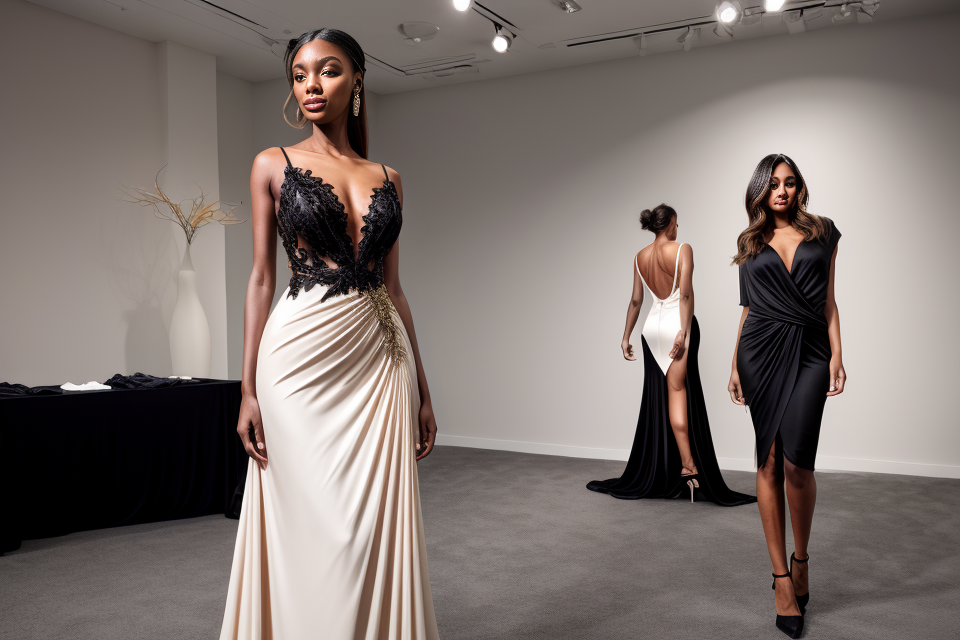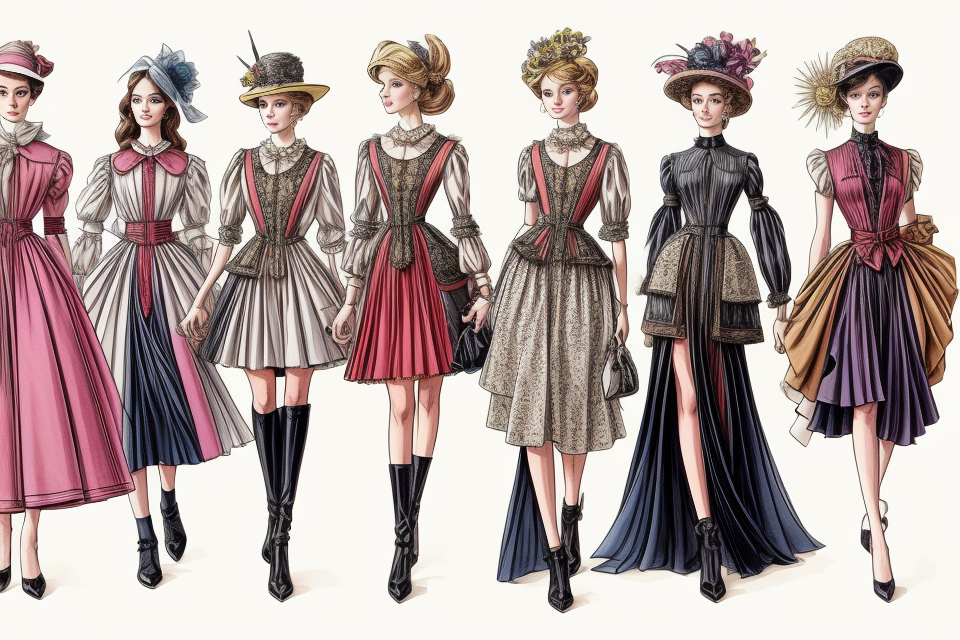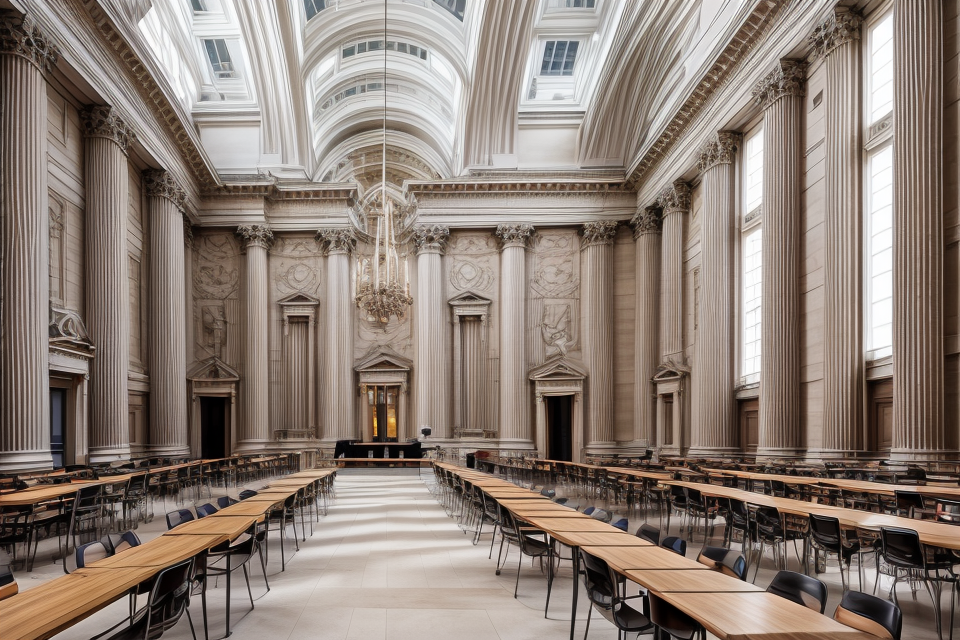
Fashion designers are the creative minds behind the clothing we wear. They are responsible for conceptualizing, designing, and producing fashion collections that reflect the latest trends and styles. From haute couture to fast fashion, fashion designers work in various areas of the industry, including high-end fashion, ready-to-wear, sportswear, and accessories. A successful fashion designer is not only creative but also has a keen understanding of the market, consumer behavior, and business strategies. In this article, we will explore the various aspects that make a successful fashion designer, from technical skills to entrepreneurial spirit. So, let’s dive in and discover what it takes to become a successful fashion designer.
A successful fashion designer is someone who has a keen eye for fashion trends, a deep understanding of the market, and the ability to create unique and desirable designs. They must also have strong business skills, including the ability to manage a team, budget effectively, and market their products. Additionally, successful fashion designers are able to collaborate with other professionals in the industry, such as manufacturers and retailers, and must be able to adapt to changing market conditions.
Understanding the Role of a Fashion Designer
Responsibilities and Tasks
As a fashion designer, one is responsible for overseeing the creative and technical aspects of designing clothing and accessories. This includes researching fashion trends, developing concepts, creating sketches and technical drawings, selecting fabrics and materials, creating prototypes and samples, collaborating with other designers and industry professionals, and presenting collections to buyers and the press.
A fashion designer’s work involves a great deal of research, as they must stay up-to-date on current fashion trends and be able to predict future trends. This involves studying runway shows, attending fashion events, and analyzing consumer behavior and preferences. Additionally, designers must have a strong understanding of textiles, fabrics, and materials, as well as an eye for detail and a sense of aesthetics.
One of the key tasks of a fashion designer is to develop concepts and create mood boards to communicate their vision. This involves creating sketches and technical drawings of designs, as well as selecting fabrics, materials, and colors that will bring the design to life. Designers must also create prototypes and samples to test the fit, functionality, and overall look of the design.
Collaboration is also a crucial aspect of a fashion designer’s work. They must work closely with other designers, manufacturers, and suppliers to ensure that their designs are produced efficiently and effectively. Additionally, designers must be able to present their collections to buyers and the press, which requires strong communication and presentation skills.
Overall, the role of a fashion designer requires a unique combination of creativity, technical skill, and business acumen. A successful fashion designer must be able to balance these competing demands and develop designs that are both commercially viable and aesthetically pleasing.
Skills and Qualities
A successful fashion designer must possess a unique combination of skills and qualities that set them apart from the rest. Here are some of the most important skills and qualities that are essential for a fashion designer to excel in their field:
- Strong sense of creativity and originality: A fashion designer must have a creative mind that is constantly generating new ideas and concepts. They must be able to think outside the box and come up with unique designs that reflect their personal style and vision. A successful fashion designer must also have a strong sense of originality, which sets them apart from other designers in the industry.
- Knowledge of fashion history and contemporary fashion trends: A fashion designer must have a deep understanding of fashion history and contemporary trends. They must be able to analyze past designs and identify the elements that made them successful, while also keeping up with the latest fashion trends and incorporating them into their designs.
- Understanding of textiles, fabrics, and materials: A successful fashion designer must have a deep understanding of textiles, fabrics, and materials. They must be able to identify different types of fabrics, understand their properties, and choose the right materials for their designs. This knowledge is essential for creating high-quality, durable, and fashionable clothing.
- Technical skills in sketching, draping, and pattern making: A fashion designer must have technical skills in sketching, draping, and pattern making. They must be able to create accurate sketches of their designs, manipulate fabrics to create the desired shape and fit, and make patterns that are suitable for production.
- Ability to work well under pressure and meet deadlines: The fashion industry is fast-paced and demanding, and a successful fashion designer must be able to work well under pressure and meet tight deadlines. They must be able to manage their time effectively, prioritize tasks, and deliver high-quality work within the given timeframe.
- Excellent communication and presentation skills: A fashion designer must have excellent communication and presentation skills. They must be able to communicate their ideas and vision clearly to clients, manufacturers, and other stakeholders. They must also be able to present their designs effectively, using visual aids and other tools to showcase their work.
- Strong leadership and teamwork skills: A successful fashion designer must have strong leadership and teamwork skills. They must be able to lead a team of designers, pattern makers, and other professionals, while also collaborating effectively with other members of the team. They must be able to delegate tasks, provide feedback, and motivate their team to achieve their goals.
Education and Training
Formal Education
A bachelor’s degree in fashion design or a related field is typically the minimum educational requirement for a fashion designer. Specialized courses in fashion illustration, draping, pattern making, and sewing are often recommended to develop the necessary skills and knowledge.
Fashion design programs usually include coursework in:
- Apparel construction and production techniques
- Textile science and fabric selection
- Design principles and aesthetics
- Fashion history and theory
- Marketing and business management
In addition to classroom learning, hands-on experience is crucial for building a strong foundation in the industry. Many programs offer opportunities for students to participate in internships or collaborate with local fashion businesses.
Graduates of accredited fashion design programs may also pursue further education through master’s or doctoral programs in fashion design or related fields, such as fashion merchandising or fashion marketing. These advanced degrees can provide specialized knowledge and training in areas like sustainable fashion, luxury fashion, or fashion business management.
Furthermore, attending fashion events, workshops, and seminars can also contribute to a fashion designer’s education and professional development. Staying current with industry trends and technological advancements is essential for maintaining a competitive edge in the ever-evolving world of fashion.
On-the-Job Training
Internships and apprenticeships with fashion designers or fashion houses are a valuable way for aspiring fashion designers to gain hands-on experience in the industry. These opportunities allow individuals to work alongside experienced professionals, learn about the design process, and develop their skills in areas such as pattern making, draping, and garment construction.
Attending industry events and networking with other professionals is also an important aspect of on-the-job training for fashion designers. These events provide a platform for designers to showcase their work, connect with potential clients or employers, and stay up-to-date on industry trends and developments.
Continuing education and professional development courses are also crucial for aspiring fashion designers to stay competitive in the industry. These courses can help individuals develop new skills, expand their knowledge of the latest fashion trends and technologies, and improve their overall professional standing. Some examples of continuing education courses for fashion designers include fashion business management, sustainable design practices, and fashion marketing and branding.
Overall, on-the-job training is a vital component of becoming a successful fashion designer. Through internships, apprenticeships, industry events, and continuing education courses, individuals can gain the skills, knowledge, and experience needed to succeed in this competitive field.
Success Factors
Business Acumen
A successful fashion designer must possess a deep understanding of the business side of fashion. This includes knowledge of marketing, sales, and production processes. The designer must have a clear understanding of the target market and consumer demographics to create collections that appeal to consumers and meet their needs.
The designer must also have the ability to analyze trends and make informed decisions about which products to produce and how to market them. They must be able to identify emerging trends and adjust their designs accordingly to stay ahead of the competition.
Furthermore, a successful fashion designer must be able to work effectively with manufacturers, suppliers, and other industry professionals. They must be able to communicate their vision and design specifications clearly and concisely to ensure that their products are produced to the highest standards.
In addition, a successful fashion designer must have strong financial management skills. They must be able to manage their finances effectively, including budgeting, forecasting, and pricing their products appropriately. This requires a deep understanding of the costs associated with producing and marketing fashion products, as well as an ability to anticipate and manage risk.
Overall, business acumen is a critical success factor for fashion designers. It allows them to navigate the complex business landscape of the fashion industry and make informed decisions that drive growth and success.
Innovation and Creativity
In the world of fashion, innovation and creativity are two of the most critical factors that contribute to a designer’s success. These qualities enable a designer to create unique and original designs that set them apart from their competitors. Here are some of the ways in which innovation and creativity can impact a fashion designer’s success:
- Ability to create unique and original designs: A successful fashion designer must have the ability to create designs that are original and unique. This means that they must be able to think outside the box and come up with fresh ideas that are not simply copies of existing designs. This requires a deep understanding of fashion history, an eye for detail, and a willingness to take risks.
- Understanding of current fashion trends and how to incorporate them into designs: In addition to being innovative, a successful fashion designer must also have a keen understanding of current fashion trends. This means staying up-to-date with the latest runway shows, fashion magazines, and social media platforms. A designer who is able to incorporate current trends into their designs in a way that feels fresh and original is more likely to succeed.
- Ability to adapt to changing trends and consumer preferences: The fashion industry is constantly evolving, and successful designers must be able to adapt to changing trends and consumer preferences. This means staying flexible and open-minded, and being willing to change direction if necessary. A designer who is able to anticipate changes in the market and adjust their designs accordingly is more likely to succeed in the long term.
Overall, innovation and creativity are essential qualities for any successful fashion designer. These qualities enable designers to create unique and original designs that stand out in a crowded market, and to stay ahead of the curve in an industry that is constantly evolving.
Networking and Collaboration
Building Relationships with Industry Professionals, Manufacturers, and Suppliers
One of the key factors in becoming a successful fashion designer is building relationships with industry professionals, manufacturers, and suppliers. This involves establishing a network of contacts who can provide support, guidance, and resources to help you achieve your goals. By cultivating these relationships, you can gain access to valuable information, opportunities, and resources that can help you succeed in the fashion industry.
Collaborating with Other Designers and Brands
Collaborating with other designers and brands is another important aspect of networking and collaboration in the fashion industry. By working together with other designers and brands, you can create unique collections that showcase your talents and strengths. Collaboration can also help you learn from others, gain new perspectives, and develop your skills as a fashion designer. Additionally, collaborations can lead to new opportunities, such as partnerships, sponsorships, and exposure in the media.
Attending Industry Events and Participating in Fashion Shows and Presentations
Attending industry events and participating in fashion shows and presentations is a crucial part of networking and collaboration in the fashion industry. By attending events such as fashion shows, runway presentations, and trade shows, you can connect with industry professionals, manufacturers, and suppliers. These events also provide opportunities to showcase your designs, gain exposure, and receive feedback from industry experts. Participating in fashion shows and presentations can also help you build your reputation as a fashion designer and establish your brand in the industry.
Marketing and Branding
Creating a Strong Personal Brand and Identity
As a fashion designer, it is crucial to establish a unique personal brand and identity that sets you apart from the competition. This includes developing a recognizable style, creating a consistent visual identity across all marketing materials, and cultivating a strong reputation within the industry.
Building a Portfolio of Work
A strong portfolio is essential for showcasing your skills and designs to potential clients and employers. It should include a range of designs that demonstrate your creativity, technical ability, and understanding of different fashion styles and trends. Your portfolio should be well-organized, visually appealing, and clearly communicate your design philosophy and aesthetic.
Using Social Media and Other Marketing Channels
Social media platforms such as Instagram, Facebook, and Twitter offer fashion designers an opportunity to promote their designs and collections to a wider audience. By creating engaging content, collaborating with influencers, and engaging with followers, designers can build a loyal online community and increase their visibility within the industry. Additionally, attending fashion events, participating in trade shows, and securing press coverage can also help to raise your profile and generate exposure for your brand.
Entrepreneurial Spirit
Being an entrepreneur is a crucial factor in becoming a successful fashion designer. This means having the ability to start and run a successful fashion business. It requires knowledge of business management, finance, and marketing. A successful fashion designer must understand the legal and regulatory requirements for running a fashion business.
A fashion designer must be able to identify and capitalize on business opportunities. This includes identifying market gaps and creating products that meet the needs of the target market. Additionally, a successful fashion designer must be able to manage finances effectively, including budgeting, forecasting, and cash flow management.
Marketing is also a crucial aspect of entrepreneurial spirit in fashion design. A successful fashion designer must be able to effectively market their products to their target audience. This includes understanding consumer behavior, creating a brand image, and developing a marketing strategy that reaches the target audience.
Understanding the legal and regulatory requirements for running a fashion business is also important. This includes knowledge of intellectual property laws, labor laws, and industry regulations. A successful fashion designer must be able to navigate these legal requirements and ensure compliance to avoid legal issues that could negatively impact the business.
In summary, entrepreneurial spirit is a critical success factor for a fashion designer. It requires knowledge and skills in business management, finance, marketing, and legal compliance. A successful fashion designer must be able to identify and capitalize on business opportunities, manage finances effectively, market their products effectively, and navigate legal requirements to ensure the success of their business.
Passion and Drive
- Strong passion for fashion and design
- A deep love and appreciation for fashion and design is a key component of success in the industry. This passion drives designers to constantly create and innovate, pushing the boundaries of what is possible.
- Having a strong vision and being able to articulate it is crucial for standing out in the competitive fashion industry.
- Dedication to creating high-quality designs and collections
- A successful fashion designer is committed to producing high-quality designs and collections that are both aesthetically pleasing and functional.
- This dedication to excellence requires a meticulous attention to detail and a willingness to put in the time and effort necessary to create exceptional pieces.
- Willingness to work hard and make sacrifices to achieve success
- Success in the fashion industry often requires long hours, hard work, and a willingness to make sacrifices in order to achieve success.
- This may include sacrificing personal time, working long hours, and putting in extra effort to ensure that designs are of the highest quality.
- A strong work ethic and determination to succeed are essential for overcoming obstacles and achieving success in the competitive fashion industry.
FAQs
1. What is a fashion designer?
A fashion designer is a professional who creates clothing, footwear, and accessories. They use their creativity and knowledge of fashion trends to design clothing and accessories that are both functional and aesthetically pleasing.
2. What makes a successful fashion designer?
A successful fashion designer has a unique and distinctive design aesthetic, is able to create clothing and accessories that appeal to consumers, has strong technical skills, is able to work well with others in the fashion industry, and is able to adapt to changing trends and consumer preferences.
3. What kind of education do I need to become a fashion designer?
There are many different paths to becoming a fashion designer. Some fashion designers have a formal education in fashion design, while others have learned through on-the-job training or through self-study. Many fashion designers have a bachelor’s degree in fashion design or a related field, such as fine arts or apparel design.
4. What skills do I need to be a successful fashion designer?
Successful fashion designers have a variety of skills, including creativity, an eye for detail, strong technical skills, knowledge of fabric and materials, the ability to work well with others, and the ability to adapt to changing trends and consumer preferences.
5. How do I start my career as a fashion designer?
Starting your career as a fashion designer can involve a variety of steps, such as getting an education in fashion design, building a portfolio of your work, networking with other professionals in the fashion industry, and gaining experience through internships or entry-level jobs. It’s also important to stay up-to-date with the latest fashion trends and to be able to adapt to changing consumer preferences.


